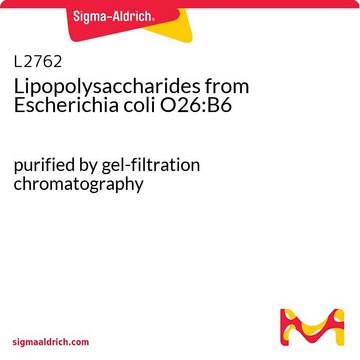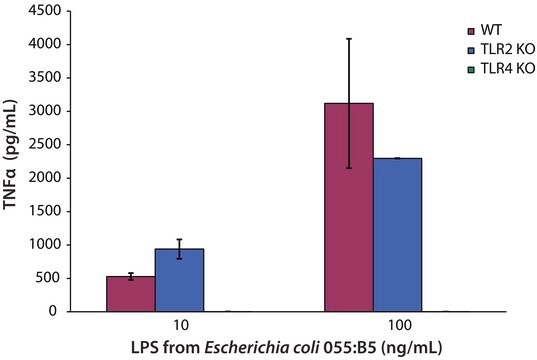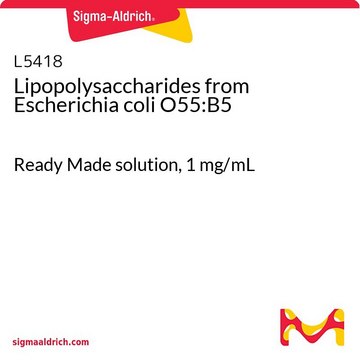L9023
Lipopolisaccaridi
Detoxified
Sinonimo/i:
LPS
Autenticatiper visualizzare i prezzi riservati alla tua organizzazione & contrattuali
About This Item
Prodotti consigliati
Origine biologica
Escherichia coli (O55:B5)
Livello qualitativo
Stato
lyophilized powder
Condizioni di spedizione
ambient
Temperatura di conservazione
2-8°C
Cerchi prodotti simili? Visita Guida al confronto tra prodotti
Descrizione generale
This product is extracted from E. coli serotype O55:B5 and purified by chromatography. The source strain is CDC 1644-70. The lipid A moiety has been partially delipidated by alkaline hydrolysis. Removal of the fatty acid portions of lipid A results in a detoxified LPS with an endotoxin level about 10,000 times lower than that of the parent LPS.
Applicazioni
I lipopolisaccaridi (LPS) sono componenti caratteristici della parete cellulare dei batteri gram negativi. Il LPS e la sua frazione lipide A stimolano le cellule del sistema immunitario innato attraverso il recettore Toll-like 4 (TLR4), un elemento della famiglia delle proteine recettoriali Toll-like, che riconosce i profili molecolari associati ai patogeni (PAMP) comuni.
Azioni biochim/fisiol
Lipopolysaccharides (LPS) are localized in the outer layer of the membrane and are, in noncapsulated strains, exposed on the cell surface. They contribute to the integrity of the outer membrane, and protect the cell against the action of bile salts and lipophilic antibiotics.
Nota sulla preparazione
Chromatographically purified; delipidized by alkaline hydrolysis
The product is soluble in water (5 mg/ml) or cell culture medium (1 mg/ml) yielding a hazy, faint yellow solution. A more concentrated, though still hazy, solution (20 mg/ml) has been achieved in aqueous saline after vortexing and warming to 70-80 oC. Lipopolysaccharides are molecules that form micelles in every solvent. Hazy solutions are observed in water and phosphate buffered saline. Organic solvents do not give clearer solutions. Methanol yields a turbid suspension with floaters, while water yields a homogeneously hazy solution.
The product is soluble in water (5 mg/ml) or cell culture medium (1 mg/ml) yielding a hazy, faint yellow solution. A more concentrated, though still hazy, solution (20 mg/ml) has been achieved in aqueous saline after vortexing and warming to 70-80 oC. Lipopolysaccharides are molecules that form micelles in every solvent. Hazy solutions are observed in water and phosphate buffered saline. Organic solvents do not give clearer solutions. Methanol yields a turbid suspension with floaters, while water yields a homogeneously hazy solution.
Avvertenze
Danger
Indicazioni di pericolo
Consigli di prudenza
Classi di pericolo
Acute Tox. 2 Oral
Codice della classe di stoccaggio
6.1A - Combustible acute toxic Cat. 1 and 2 / very toxic hazardous materials
Classe di pericolosità dell'acqua (WGK)
WGK 3
Punto d’infiammabilità (°F)
Not applicable
Punto d’infiammabilità (°C)
Not applicable
Dispositivi di protezione individuale
Eyeshields, Gloves, type N95 (US)
Scegli una delle versioni più recenti:
Possiedi già questo prodotto?
I documenti relativi ai prodotti acquistati recentemente sono disponibili nell’Archivio dei documenti.
I clienti hanno visto anche
Ding, H.F., et al.
Journal of Medical Microbiology, 31, 93-93 (1990)
Chong Liu et al.
World journal of gastroenterology, 15(46), 5843-5850 (2009-12-10)
To investigate the dysfunction of the immunological barrier of the intestinal mucosa during endotoxemia and to elucidate the potential mechanism of this dysfunction. Male Wistar rats were randomly distributed into two groups: control group and lipopolysaccharide (LPS) group. Endotoxemia was
Evangelos J Giamarellos-Bourboulis et al.
PloS one, 4(12), e8393-e8393 (2009-12-29)
The pandemic by the novel H1N1 virus has created the need to study any probable effects of that infection in the immune system of the host. Blood was sampled within the first two days of the presentation of signs of
James A Listman et al.
Molecular immunology, 45(9), 2667-2677 (2008-03-01)
The immediate early (IE) proteins of human cytomegalovirus (hCMV) have diverse roles in directing viral and host cell transcription. Among these is the ability of IE2 to induce transcription of the IL1B gene that codes for IL-1beta in monocytes. This
Sophie Van Linthout et al.
Journal of molecular medicine (Berlin, Germany), 89(2), 151-160 (2010-10-26)
The protective effects of high-density lipoprotein (HDL) under lipopolysaccharide (LPS) conditions have been well documented. Here, we investigated whether an effect of HDL on Toll-like receptor 4 (TLR4) expression and signalling may contribute to its endothelial-protective effects and to improved
Il team dei nostri ricercatori vanta grande esperienza in tutte le aree della ricerca quali Life Science, scienza dei materiali, sintesi chimica, cromatografia, discipline analitiche, ecc..
Contatta l'Assistenza Tecnica.




